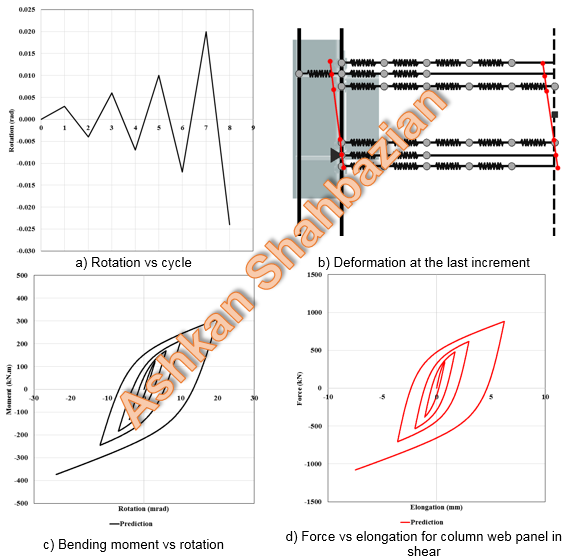Cyclic component-based method for steel joints (EQUALJOINTS project)
The behaviour of steel joints under cyclic load is characterised by hysteretic loops which includes the material degradation that causes failure of the joint. Predicting behaviour of steel joints is complex as several phenomena affects joint behaviour such as material and geometrical nonlinearity. Under cyclic load, this behaviour is further complicated by loading and unloading. For static monotonic loads, it is possible to accurately predict the moment rotation response for a wide range of joint configurations by applying the principles of the component-based method. However, knowing appropriate behaviour of each component is necessary. At this stage, it is possible to determine force-elongation behaviour of each component up to the yielding (CEN, 2005). For the cyclic loads, the usual approach is to develop multi-parameter mathematical expressions that are able to reproduce the range of hysteretic behaviours for a given group of steel joint typologies which should be fitted with experimental or numerical results.
The complexity of the behaviour of steel joints led to a wide range of distinct approaches to provide practical design procedures. The component-based method is one of those approaches which is being used widely. The component-based model to predict moment-rotation behaviour of steel and composite joints was originally proposed by Tschemmernegg et al. (1987). Since then, component-based method has been adopted in Eurocode 3 part 1.8 (CEN, 2005). Component-based method considers any type of joints as set of individual spring element/component. To use this method in design, for each component the elongation/stiffness and maximum force (yield) should be computed and assembled in appropriate position to assemble a form of spring elements which represents the behaviour of whole joint. This method has a potential to be used when components have nonlinear elongation-force behaviour. However, as we have nonlinear material, the FE method should be used to determine bending moment and rotation of the joint.

Ashkan Shahbazian
I have developed a FE program for nonlinear analysis of steel joints under cyclic load. this program generates hysteretic behaviour of the joint and components. This tool has been validated by comparison with experimental studies. Despite its simplicity compare to detailed 3D FE simulations, this tool predicts behaviour of the joint very well. Thus, this tool can be used for daily design.

ashkan shahbazian;
EQUALJOINTS
